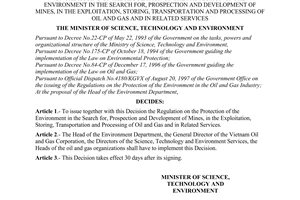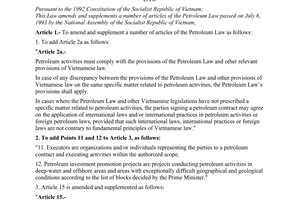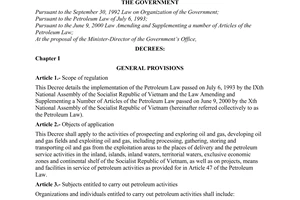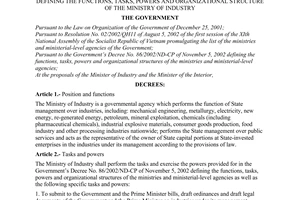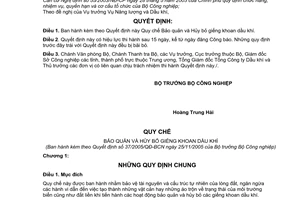Nội dung toàn văn Decision No. 37/2005/QD-BCN regulation on maintenance abandonment oil gas wells
|
MINISTRY OF
INDUSTRY |
SOCIALIST REPUBLIC OF VIETNAM |
|
No. 37/2005/QD-BCN |
Hanoi, 25 November 2005 |
DECISION
ON PROMULGATION OF THE REGULATION ON MAINTENANCE AND ABANDONMENT OF OIL AND GAS WELLS
MINISTER OF INDUSTRY AND TRADE
Pursuant to the Oil and Gas Law dated 06 July 1993 and the Law on amendments and supplements to certain articles of the Oil and Gas Law dated 09 June 2000;
Pursuant to the Government’s Decree No. 48/2000/ND-CP dated 12 September 2000 on details of the enforcement of the Oil and Gas Law;
Pursuant to the Government’s Decree No. 55/2003/ND-CP dated 28 May 2003 on functions, missions, authority and organizational structure of the Ministry of Industry;
At the request of the Head of the Department of Energy, Oil and Gas
DECIDES:
Article 1. The regulation on maintenance and abandonment of oil and gas wells is enclosed to this Decision.
Article 2. This decision takes effect 15 days after the date of publishing on the Official Gazette. Previous regulations contrary to this Decision shall be rendered null and void.
Article 3. Chief of the Ministry's Office, Chief of the Ministry's Inspectorate, heads of departments and bureaus of the Ministry, directors of provincial departments of industry, General Director of PetroVietnam and heads of relevant units shall be responsible for enforcing this Decision./.
|
|
MINISTER OF INDUSTRY
|
REGULATION
MAINTENANCE AND ABANDONMENT
OF OIL AND GAS WELLS
(Under the Decision No. 37/2005/QD-BCN dated 25 November 2005 by Minister of
Industry)
Chapter 1:
GENERAL
Article 1. Objectives
This Regulation aims at protecting resources and natural structure of the earth’s entrails and precluding activities that create obstacles or disarray in marine environment and land during the progress of maintenance and abandonment of oil and gas wells.
Article 2. Scope of regulation
This Regulation applies to activities of maintenance and abandonment of wells perforated or managed by operators, organizations or individuals (referred to as the Operators) during the exploration and exploitation of oil and gas in territories, exclusive economic zones and continental shelves of the Socialist Republic of Vietnam.
Article 3. Terminology
In this Regulation, the following words and phrases are construed as follows:
1. “Well maintenance” refers to the fortification of plugs and installation of devices inside the well to maintain the safety of the well in a defined length of time for later exploration, test and exploitation in favorable conditions.
2. “Cement retainer” is used during the high-pressure squeeze of cement to block the cement flow from moving upwards and downwards in the well. A cement retainer is a sealing tool made of metallic material(s). Though it is not retrievable, it can be perforated and dismantled.
3. “Temporary guide base” is made of steel and laid on the seabed to guide the bottom hole assembly and large-diameter directional pipes, to support underwater equipment and to anchor directional cables in case of subsea wellheads.
4. "Well abandonment” refers to the fortification of cement plugs, installation of bridge plugs, removal and retrieval of certain ducts in the well and eradication of impediments around the wellhead.
5. “Well intervention” refers to the partial or full maintenance or abandonment of an oil well or gas well.
6. “Annulus" refers to part(s) of the well, in which casing has been set and perforations are made to facilitate circulation between a formation and the shaft or among different casings.
7. “Cement plugs” refer to solid blocks formed by cement slurry that is pumped into a certain depth of the shaft. They separate different formations along the shaft.
8. “Bridge plugs" isolate the shaft and separate different voids where casing is set. They are made of metallic material(s) and rubber and can be easily perforated and dismantled.
9. "Vietnam Oil and Gas Group” (international trading name: “PETROVIETNAM”) is a state-owned corporation established by the government of Vietnam to carry out activities and engage in contracts with entities in the sector of oil and gas as per the Law on oil and gas.
10. “Emergencies” mean:
a/ Severe impacts caused by natural incidents or disasters such as lightning, storm, tornado or seism.
b/ Fire, explosion, accidents or breakdowns of the equipment or machinery, structural collapse or damage.
c/ Plague or quarantine
d/ Events or circumstances similar in nature to those stated above.
Article 4. Responsibilities of the operators for the quality of well intervention
Ministry of Industry’s endorsement of well intervention reports by the operators as per Article 8 of this Regulation shall not absolve the operators from their responsibilities for the quality of well intervention and resultant consequences for safety and environment if well intervention is proved to have not complied with this Regulation.
Article 5. Outline well intervention plan
The operators must set up and include outline well intervention plan(s) in the perforation plan(s) of the entire field or each well that have not been exploited.
Chapter 2:
PROCEDURE FOR APPROVAL AND DETAILS OF WELL INTERVENTION PLANS
Article 6. Submission of a well intervention plan
The operators, before conducting a well intervention process, must submit the plan thereof to the Ministry of Industry for approval no later than five (05) working days prior to its commencement, except for emergencies.
Article 7. Details of a well intervention plan
A well intervention plan must include but is not limited to:
1. Reason(s) for well intervention
2. Summary of well drilling and completion, fundamental data on the well and its exploitation, excerpts from geological and well logging documents, assessment results of cement stones' bond to outer sides of exploitation casings and pressure at formations, and other written materials in connection with the well or well bores to be abandoned or maintained.
3. Well structure diagram composed of: Well depth, casing depth, height of cement columns in tubing-casing annulus; type and density of fluids in the well and in tubing-casing annulus; devices installed inside the shaft. Slant drilling depth, vertical depth, measured depth (of the point along the course of the wellbore), angles and azimuth must be specified in case of a directional or horizontal well.
4. Methods for positioning of bridge plugs and cement plugs, including positioning manner(s), volume of cement slurry and of pump liquid, interval and depth of positions, test approach for pressure and load. Cutting method and depth of casing cuts for well abandonment must be specified.
5. Plan(s) for wellhead cleanup and survey prior to well intervention or relocation or dismantling of the oil platform.
6. Schedule for well intervention or periodic inspection plan(s) for maintained wells.
7. Environment protection reports as per Article 7 of the Regulation on environment protection regarding the search, exploration and development of fields, exploitation, storage and transportation of oil and gas, and relevant services under the Decision No. 395/1998/QĐ-BKHCNMT dated 10 April 1988 by the Minister of Science, Technology and Environment.
Article 8. Well intervention report
1. The operators must report the process of well intervention and submit resultant documents to Vietnam Oil and Gas Group in 21 days upon the completion of such process.
2. Such report must include all data and documents on well intervention, including the layout of actual conditions of the intervened well, and written materials acquired from final assessments of the seabed and sea surface around the well.
Article 9. Wellhead severing by explosive charge
1. The operators shall employ mechanical cutters to severe and retrieve wellheads, except for special circumstances.
The operators must send the plan(s) for wellhead severing by explosive charge, if required in special circumstances, to the Ministry of Industry for approval.
2. When using explosive to severe wellheads and casings, the operators must adhere to, in a strict manner, the regulations on safe use of explosive and on environment safety and protect as per Vietnam’s laws and international practices.
Chapter 3:
WELL MAINTENANCE
Article 10. General requirements
The operators must assure that all wells under their management, when maintained, must meet these requirements:
1. The shaft is secured all the times even though the wellhead's devices are broken or removed. Formations are isolated from each other and from the surface.
2. The well can be reused for drilling, research, exploitation, repair or other activities or can be abandoned anytime in the easiest and safest manners.
3. Hindrance caused by devices to the surrounding environment must be reduced to the least extent.
Article 11. Classification of wells to be maintained
There are three classes of wells subject to their conditions:
Class 1: Wells that require long-term maintenance (3 years or more), including those on which research shows economic benefits but exploitation plans are yet available.
Class 2: Wells that require temporary maintenance (from 1 to 3 years) including reserves planned for exploitation.
Class 3: Wells that require short-term maintenance (less than 1 year), including those in use, on hold, under repair or ready for exploitation.
Article 12. Shaft maintenance
1. The installation of devices or fortification of maintenance plugs must occur in such a manner that pressure accumulated under such plugs is moderated before they are removed upon well reopening.
2. Sucker rods in class 1 wells, when maintained, must be pulled out of the wellhead. Moreover, cement plugs or bridge plugs must be inserted to separate exposed formations. Plugging method shall be subject to Charter III of this Regulation.
3. Sucker rods in class 2 wells may remain inside in pumping position. Such wells, when maintained, must be filled with maintenance liquid.
4. Class 3 wells may remain entirely intact but valves must be sealed and all hand wheels must be remove (except for wells with subsea wellheads)
Article 13. Well maintenance liquid
The operators must assure that class 1 and class 2 wells, when partially or wholly maintained, must be filled with a liquid whose density suffices to moderate formation pressure in the well prior to the commencement of well maintenance activities. The maintenance liquid must be treated to protect devices from corrosion.
Article 14. Subsea wellhead maintenance
1. Directional cables for the wells with subsea wellheads must be severed and retrieved before the displacement of the platform.
2. For maintained or completed wells, the inner side of the wellhead must be treated for anti-corrosive effect and the outer side must be protected against damage in case of collision. Devices must be set to locate the wellhead easily.
3. The operators must set up signal buoys subsea wells maintained in waters less than 20 meters deep, in order to protect wellheads, directional piles, traversing ships and boats.
Article 15. Maintenance of surface wellheads
1. A christmas tree must be installed on wellheads of the wells exploited and maintained under a fixed platform. All hand wheels except for check vale(s) must be removed. Branch pipes and low-pressure manometers must be discarded. Pipe ends and manometer legs must be fitted with blind flanges and plugs. The top of the wellhead must be mounted with a signboard (0.4m x 0.2m), which displays the name of the field and well, the full name of the operator responsible for maintenance, starting time of maintenance, reason(s) and duration of maintenance.
2. Wells on land shall be maintained in manners similar to those stated in Section 1 of Article 26. Furthermore, they shall be surrounded by a reinforced concrete barrier (4m x 4m x 2m), on which a signboard (0.4m x 0.2m) is mounted. Such signboard shall display the name of the field and well, the full name of the operator responsible for maintenance, starting time of maintenance, reason(s) and duration of maintenance
Article 16. Frequency of maintained well inspection
The operators shall be responsible for inspecting wells under maintenance on the following basis of time:
- On annual basis for class 1 wells.
- On quarterly basis for class 2 wells.
- On monthly basis for class 3 wells.
Article 17. Duration of maintenance
The operators shall be responsible for exploiting or abandoning wells under long-term maintenance in six (06) years upon maintenance, unless approved by the Ministry of Industry for extension of well maintenance time.
Chapter 4:
WELL ABANDONMENT
Article 18. General requirements
Well abandonment must meet these requirements:
1. The shaft of an abandoned well must be maintained intact. In other words, fluids cannot circulate from one formation to another or to the seabed, water surface or land upon the removal or displacement of counter-pressure device(s) or the christmas tree on the wellhead.
2. When well abandonment completes, the seabed or surface around the well must be cleaned. No obstacles or disturbance to original condition of the natural environment shall exist.
Article 19. Severing and retrieval of casings and wellheads
1. The operators cannot retrieve any casing inserted into the shaft, unless otherwise permitted by PetroVietnam in writing. The process of retrieval, if permitted, must abide by this Regulation.
2. All wellheads must be severed and retrieved. The minimum length of the underground or subsea part severed shall be 3 meters. Special circumstances shall be reported in writing to PetroVietnam for its decisions.
3. Certain requirements for severing casings:
a/ If the overlapping section of two casings is not cemented, the inner casing can be severed and retrieved. The length of the cut is subject to the height of the cement columns in the tubing-casing annulus, as shown in well logging documents.
b/ If excess pressure likely builds up in tubing-casing annulus outside the casing, the casing most adjacent to the subsea side of the wellhead must be perforated and the well must be regulated by counter-pressure device(s) before and during the severing of casing(s).
c/ Before casing(s) is (are) severed, the density of the fluid inside the well must be adjusted according to the endurance limit of the strata under the casing before the casing severed.
d/ Each casing must be severed and retrieved separately. Two (02) or more casings cannot be simultaneously severed and retrieved, except for surface casings.
Article 20. Positions of plugs in openhole sections of a well
1. Formations with oil deposit, formations with abnormal pressure or formations where fluids leak from openhole section(s) of a well must be isolated entirely by cement plugs. Moreover, these plugs must seal 50 meters above and 50 meters below such formations (Annex - Picture 1).
2. If the length of the openhole section is 250 meters or less and its diameter is less than 215.9 millimeters (8 to 1.2 inches), cement plugs must be located 50 meters, from the bottom of the well, above the shoe of the deepest casing (Annex - Picture 2).
3. If the length of the openhole section is more than 250 meters and formations in such section do not have oil or pressure anomaly, only one 100-meter-long cement plug shall extend to 50 meters above and below the shoe of the deepest casing (Annex - Picture 3).
4. If the openhole section bears abnormal pressure or has oil or gas formations, in which the bottom hole assembly, drill rod(s), casing(s) and other equipment are trapped, the devices enmeshed must be retrieved to extricate the openhole section to the maximum extent and to occlude and abandon such section according to Section 1, Article 12 of this Regulation.
Article 21. Positions of plugs in borehole sections with casings
1. In order to isolate the well’s sections with casing(s) from openhole sections, a balanced cement plug at least 100 meters in length shall be placed and extend to 50 meters above and 50 meters below the shoe of the deepest casing (Annex - Picture 4).
2. If the shaft’s conditions do not facilitate the use of a balanced cement plug, one of these methods may apply:
a/ Bridge plug: A bridge plug shall be placed under the shoe(s) of the casing(s) within 50-meter coverage and a 100-meter-long or longer cement plug shall be positioned immediately above the bridge plug (Annex - Picture 5).
b/ Cement retainer: The shoe(s) of the casing(s) may be isolated by placing a cement retainer in a 50-meter distance from the shoe(s) and squeezing cement through the retainer. The volume of the cement slurry must suffice to create a 100-meter-long cement plug under the cement retainer. Another cement plug at least 15 meters in height shall be placed on the cement retainer (Annex - Picture 6).
c) If a cement plug isolates the overlapping section of a liner's top from the shoe of the prior casing, such plug must be at least 100 meters in length and extend to 50 meters above and 50 meters below the liner's hanging point (Annex - Picture 7).
d/ If the casings penetrate through salt formations or unconsolidated (running) sand formations, a cement plug shall be set in the entire formations to counter external pressure and to protect casings from distortion. If the thickness of such a formation is 200 meters or more, there must be at least two cement plugs, one of which is set in the bottom limit of the formation and the other is set in the top limit (Annex - Picture 8).
Article 22. Abandonment of wells with perforated formations
The entrance(s) to perforated formations must be isolated in succession by bridge plugs solely or, in permissible distances, with cement plugs. The process of isolation shall incorporate one of these methods:
1. Replacement by cement plug: A balanced cement plug is set in an annular space and extends from 15 to 30 meters above and below the space to the nearest bridge plugs (Annex - Picture 9).
2. Bridge plug: Annular spaces can be isolated by a bridge plug (or production packer with plug) extending to 15 to 30 meters from the top of the spaces and a cement plug at least 15 meters in length placed onto the bridge plug (Annex - Picture 10).
3. Cement squeezing: Cement shall be squeezed into annular spaces to isolate formations with abnormal pressure and to prevent fluids flowing through formations and under casings. A cement retainer placed at least 15 meters above the annular space (Annex - Picture 11a) or a rod set with counter-pressure device shall inject cement. Furthermore, at least 25 meters of cement must be retained in all squeezing tools left in the well.
Article 23. Remedial methods
1. Casing perforation and squeezing: At least 100 meters of well-bonded cement must be injected into the shoe(s) of front casing(s) in order to preclude the circulation of fluids through formations and tubing-casing annulus. An alternative solution is the perforation of the inner casing at the depth of 100 meters above the shoe of the casing in front of the perforated casing. A cement retainer or packer shall squeeze a sufficient volume of cement slurry covering 100 meters of the tubing-casing annulus into such perforation at a pressure level not exceeding the fracture pressure (Annex - Picture 12).
2. Casing perforation and circulation: If squeezing is not feasible due to the allowable safety limit of the casing, the inner casing must be perforated in additional position(s) most adjacent to and under the shoe of the prior casing and cement shall be squeezed in to cover a 100-meter area in the tubing-casing annulus inside the perforated section(s) (Annex - Picture 13).
3. Perforations as stated in Section 1 and 2 of this Article shall be cemented as defined for annular spaces in Article 14.
Article 24. Plugging upon severing of casings
1. When casing(s) is (are) severed and retrieved according to Section 2 and 3 of Article 11, head(s) of the severed casing(s) must be isolated in one of these manners:
a/ Replacement by cement plug: a 100-meter-long balanced cement plug shall isolate the casing head and extend to 50 meters above and below the head of the severed casing (Annex - Picture 14).
b/ Cement squeezing: a cement retainer shall be placed in a larger casing and 50 meters above the head of the severed casing to inject cement. The volume of cement slurry must suffice to fill up 100 meters of the casing under the retainer (covering 50 meters inside and another 50 meters on the head of the severed casing) and 15 meters of the retainer (Annex - Picture 15).2. Before surface casings and directional pipes are severed and retrieved, one bridge plug shall be set inside surface casings, for offshore platforms, 200 meters under the seabed or, for land-based wells, under the rotary table. One 100-meter-long surface cement plug shall be placed on the bridge plug.
3. For onshore wells, heads of the surface casings and directional pipes severed must be filled with cement and the ground base of the well must be leveled out to restore the original ambiance. A steel signboard 0.4m x 0.2m shall be placed at the well and display the names of the field, the well and the operator(s) and the date of abandonment.
Article 25. Requirements for plug testing
1. Testing of location and load bearing of cement plugs:
a/ The test shall only occur at least six (06) hours after cement plugs harden up. Device(s) shall be dropped down to locate the plugs and a load of at least 10 tons shall be used to check the precision of location(s) and cement hardening quality.
b/ If cement plugs are located away from the planned positions or fail to bear the test load, they shall be replaced then locations and strength of new cement plugs shall be tested as stated above.
2. Cement plugs and bridge plugs as stated in Section 2 and 3 of Article 12 must undergo pressure test(s) at a pressure level 3459 KPa (500 psi) higher than the formation's tolerance test pressure at the casing’s shoe in 15 minutes. Such test(s) shall assert the isolation of openhole sections under the shoe of the deepest casing.
3. Cement plugs and bridge plugs as stated in Section 1, 2, 3 and 4 of Article 13 must undergo pressure test(s) at a pressure level that is 3450 KPa (500 psi) higher than the formation’s tolerance test pressure at the casing's shoe.
4. Cement plugs and bridge plugs as stated in Article 14 must undergo pressure test(s) at a pressure level 3450 KPa (500 psi) higher than the pore pressure of tested formations.
5. Cement plugs and bridge plugs as stated in Section 1 of Article 16 must undergo pressure test(s) at a pressure level that is 3450 KPa (500 psi) higher than the tolerance test pressure at the shoe of the following casing.
6. Test pressure must not decline by more than 10% in 15 minutes for the plugs to pass the test(s).
Article 26. Liquid for well abandonment
1. The well must be filled with a liquid whose density is adequate to moderate the pressure in formations prior to the process of partial or full well abandonment.
2. The liquid in the well must be treated to prevent casings from being corroded.
3. Openhole sections, before covered by cement plugs, must be installed with a plug made of a highly viscous buffer solution that avert the formation of cement deposit in the bottom of the well.
Article 27. Cement for well abandonment
Cement for well plugging, after having hardened up for eight (08) hours, must have the lowest compressive strength of 3000 KPa.
Article 28. Seabed survey after well abandonment
The operators must assure that the seabed surrounding the wellhead is prudently surveyed to have all obstacles removed after the abandonment of a well. Documents on the final seabed survey must be enclosed to the well abandonment report according to Article 8 of this Regulation.
Chapter 5:
INSPECTION AND SETTLEMENT OF VIOLATIONS
Article 29. Inspection
PetroVietnam shall be entitled to conduct periodic inspections as per Article 27 of this Regulation or ad-hoc inspections of the operators’ activities related to well abandonment or maintenance.
Ministry of Industry, when necessary, shall be responsible for leading and cooperating with PetroVietnam to form an inspection team to scrutinize the operators’ activities in connection with well maintenance or abandonment. In every circumstance, the operators must provide all supports to the inspection team’s works.
Article 30. Supervision
Ministry of Industry and PetroVietnam shall be responsible for guiding and supervising the operators’ compliance with this Regulation.
Article 31. Supervisor’s rights
The full-time on-site supervisor(s) assigned by PetroVietnam shall be entitled to request the operators to present the plans for well abandonment or maintenance. Moreover, they shall be entitled to supervise the resultant process according to this Regulation.
Article 32. Settlement of violations
The operators in violation of this Regulation shall assume all liabilities for damage caused and incur penalties as per the Law on oil and gas and current regulations of Vietnam. Furthermore, they shall bear the obligation to re-perform the maintenance or abandonment of the well(s) at requests of the Ministry of Industry./.
ANNEX
WELL INTERVENTION DIAGRAM


